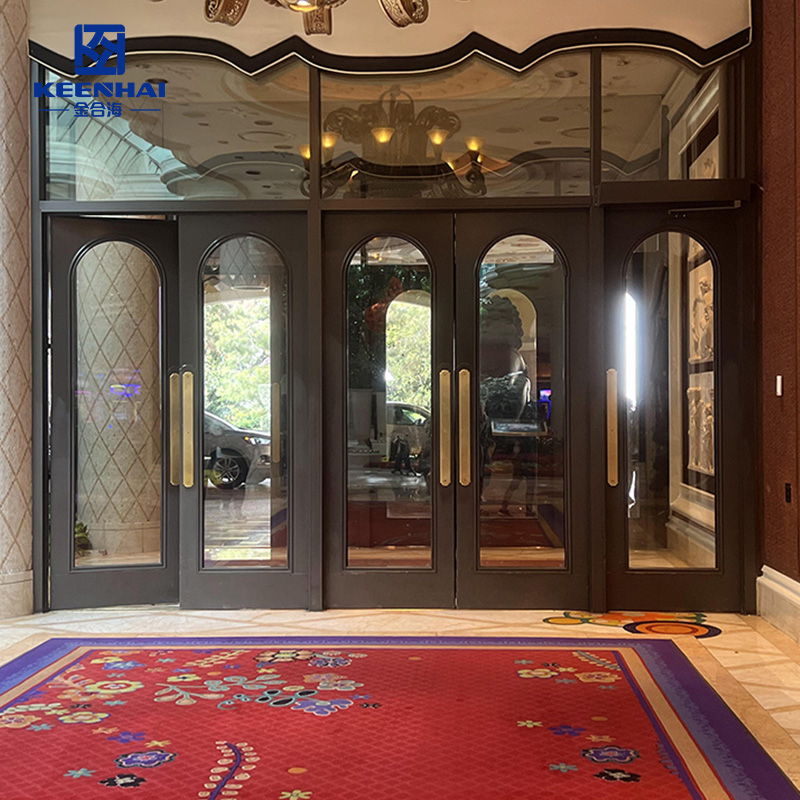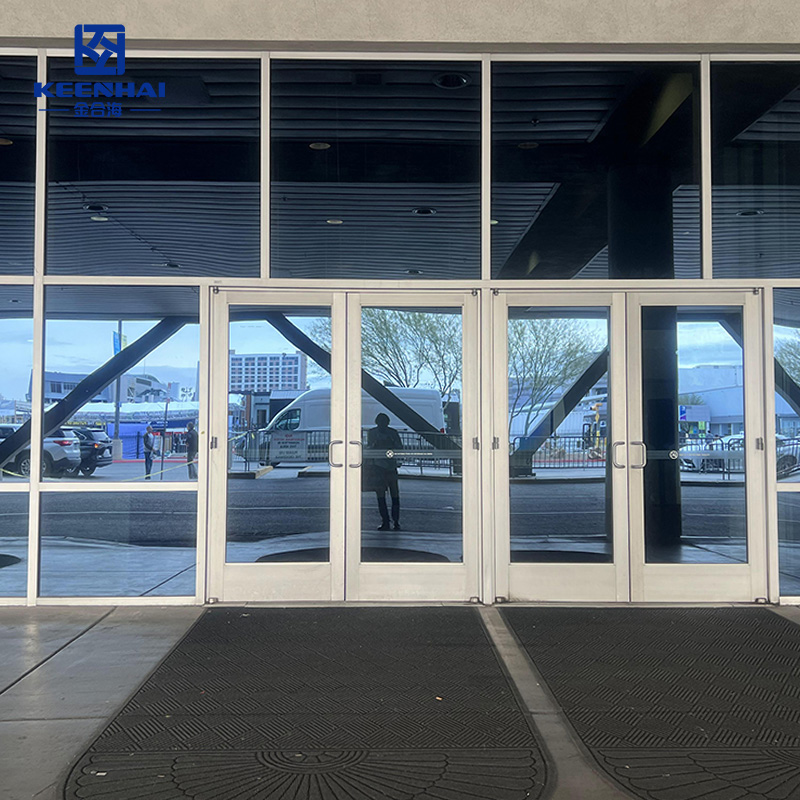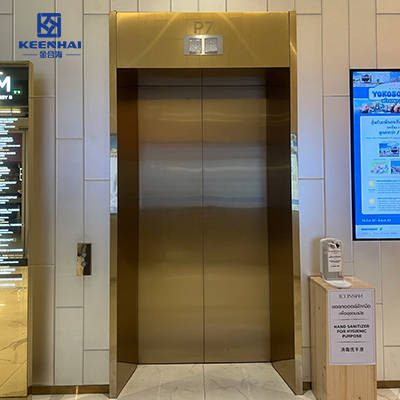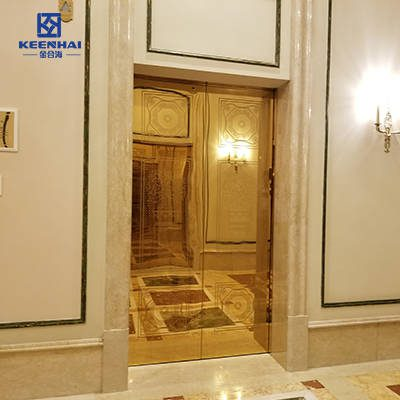Stainless steel glass doors are strong enough to handle heavy usage in exterior environments. With high-grade stainless steel and tempered or laminated glass, they resist impact, corrosion, and weathering, making them ideal for coastal hotels, high-rise offices, and commercial entrances. Regular maintenance further extends their lifespan and performance.
1. Material Strength and Durability
When it comes to exterior applications, Stainless Steel Glass Doors stand out because they combine toughness with sleek aesthetics. The material choice and structural design determine whether these doors can withstand daily wear, extreme weather, and heavy usage in commercial and residential environments.
1.1 Stainless Steel Grade Comparison
Choosing the right stainless steel grade is crucial for durability and corrosion resistance. For instance, 304, 316, and 430 grades have very different performance characteristics:
| Stainless Steel Grade | Korozyon Direnci | Hardness (Brinell) | Approx. Price per sq.ft |
|---|---|---|---|
| 304 | High | 70 | $45-$55 |
| 316 | Very High | 75 | $55-$70 |
| 430 | Moderate | 65 | $35-$45 |
-
304 is excellent for most urban environments and high-traffic areas.
-
316 is ideal for coastal or humid locations where salt exposure is frequent.
-
430 is more budget-friendly but requires regular maintenance to avoid rust.
In practice, many luxury hotels along coastlines choose 316-grade Stainless Steel Entrance Doors for their combination of strength and corrosion resistance.
1.2 Glass Type and Thickness Considerations
The glass in these doors isn’t just for looks—it plays a vital role in strength and safety. Tempered or laminated glass is standard for exterior doors, offering high impact resistance. Thickness typically ranges from 10mm to 19mm depending on the door size and traffic requirements.
-
10–12mm tempered glass – suitable for light commercial or low-rise residential use.
-
12–19mm laminated glass – recommended for high-traffic entries, high-rise buildings, and locations prone to strong winds.
For example, a Paslanmaz Çelik Sürgülü Kapı installed in a corporate lobby might use 15mm laminated glass to handle frequent opening and closing while maintaining transparency.
1.3 Corrosion and Weather Resistance
Exterior doors face rain, snow, humidity, and UV exposure. High-quality stainless steel combined with proper finishing techniques like PVD coatings ensures that the doors stay rust-free and retain their shine for decades.
-
Coastal hotels often select 316-grade stainless steel with a PVD finish to prevent corrosion from salty air.
-
Urban high-rises may use 304-grade steel with a mirror finish to maintain a modern look without sacrificing durability.
Regular maintenance involves:
-
Cleaning the surface weekly with a non-abrasive cleaner.
-
Inspecting seals and glass edges for any moisture infiltration.
-
Applying protective wax or PVD touch-up as needed.
These steps ensure that your stainless steel doors remain strong enough to handle heavy usage while maintaining a polished, professional appearance.

2. Resistance to Environmental Factors
Exterior doors must endure wind, rain, sunlight, and temperature swings without losing strength or appearance. Stainless Steel Glass Doors are engineered to meet these demands, providing durability and long-term reliability in real-world conditions.
2.1 Wind and Impact Resistance
High-rise buildings and coastal properties require doors that can handle strong gusts. Reinforced stainless steel frames combined with tempered or laminated glass deliver impact resistance exceeding 90 mph wind loads, preventing frame deformation and glass shattering.
-
Laminated glass stays intact under heavy impact.
-
Reinforced anchor points distribute stress evenly.
-
Commercial lobbies and hotel entrances benefit from these measures, ensuring doors operate smoothly even during storms.
2.2 UV and Sunlight Exposure
Continuous sun exposure can fade finishes and weaken materials. Using high-grade stainless steel with UV-resistant coatings on tempered glass prevents discoloration and surface degradation, keeping the entrance visually pristine.
-
Glass coatings block up to 99% of UV rays, reducing interior fading.
-
Sun-facing offices or retail façades maintain consistent clarity and strength.
-
For sliding applications, Stainless Steel Sliding Doors offer the same UV protection while providing smooth operation in high-traffic areas.
2.3 Rain, Snow, and Moisture Protection
Water and moisture are major concerns for exterior installations. Premium stainless steel grades and laminated glass resist corrosion and seal failures, even in coastal or snowy environments.
-
Coastal sites often use 316 paslanmaz çelik to combat rust from salt exposure.
-
Sloped sills and weather stripping prevent water intrusion and ice buildup.
-
Regular cleaning and seal inspections every 3–6 months ensure consistent performance.
These design measures make the doors reliable in diverse weather conditions, whether installed in a busy urban office, a seaside hotel, or a commercial building exposed to heavy rain and snow.
3. Structural and Design Considerations
Exterior doors must not only resist weather but also maintain structural integrity under heavy use. Stainless Steel Glass Doors are engineered with reinforced frames and precision hardware to ensure smooth, reliable operation over years, even in high-traffic areas.
3.1 Door Frame Reinforcement
A strong frame distributes stress and prevents deformation under repeated use or impact. Key measures include:
-
Multi-layer steel cores that enhance rigidity without excessive weight.
-
Reinforced corner brackets and welds that resist bending under heavy loads.
-
Integration with building structure using anchor plates rated for 2000+ lbs in commercial installations.
| Stainless Steel Grade | Tensile Strength (MPa) | Recommended Applications | Typical Cost Factor |
|---|---|---|---|
| 304 | 515 | Standard commercial | 1x |
| 316 | 580 | Coastal/High humidity | 1.3x |
| 430 | 450 | Interior doors | 0.9x |
This table helps architects and contractors quickly choose the right grade based on strength, corrosion resistance, and cost.
3.2 Hinge, Lock, and Hardware Durability
Hardware is often the first failure point. High-quality stainless steel hinges, locks, and handles can withstand 50,000+ operational cycles without loosening or rusting.
-
Ball-bearing hinges reduce friction and squeaking.
-
Weather-sealed locks prevent water ingress and corrosion.
-
Keyless or electronic locking systems can be integrated for modern office entrances or hotel lobbies.
3.3 Integration with Exterior Wall Systems
Proper installation with exterior walls ensures energy efficiency and prevents water intrusion:
-
Use of flexible sealants compatible with steel and glass interfaces.
-
Flush or recessed installation to maintain clean lines and reduce wind pressure.
-
Coordination with curtain walls or masonry for consistent thermal performance and weatherproofing.
Well-engineered structural integration means doors remain aligned, secure, and visually sleek for decades, even in high-rise, coastal, or commercial buildings.

4. Thermal and Energy Efficiency
Proper thermal design ensures Stainless Steel Glass Doors perform reliably in all climates while minimizing energy costs. Insulation, glazing, and sealing all contribute to maintaining indoor comfort, especially in buildings with heavy sun exposure or cold winters.
4.1 Insulated Glass Options
Double- or triple-pane glass dramatically reduces heat transfer, helping interior spaces stay cooler in summer and warmer in winter. Low-E coatings reflect infrared radiation without sacrificing visible light, and argon-filled gaps between panes improve thermal performance by up to 50% compared to standard single-pane glass.
-
Triple-pane systems can achieve U-values as low as 0.15 W/m²·K, ideal for high-rise office buildings or luxury residential entrances.
-
Laminated layers provide both insulation and enhanced impact resistance, useful in coastal or windy locations.
4.2 Heat and Cold Resistance
Metal frames naturally conduct heat, but reinforced steel profiles combined with thermal breaks can reduce energy loss. Key considerations include:
-
Thermal breaks inserted between interior and exterior steel surfaces.
-
Sealed gaskets that maintain insulation performance in temperatures ranging from -30°C to 60°C.
-
Compatibility with HVAC systems to prevent hotspots near doors.
Buildings in extreme climates, from snowy mountain resorts to sunny urban towers, benefit significantly from these measures.
4.3 Preventing Condensation and Fogging
Condensation can damage hardware and degrade visual clarity. Effective prevention includes:
-
Properly ventilated frames to allow moisture escape.
-
Anti-fog coatings on interior glass surfaces.
-
Ensuring glass edge spacers and sealants are rated for long-term exposure to humidity and temperature fluctuations.
By combining insulated glazing, thermal breaks, and moisture management, Stainless Steel Glass Doors maintain both energy efficiency and aesthetic clarity, even in challenging exterior conditions.

5. Maintenance and Longevity
Proper maintenance ensures Stainless Steel Glass Doors stay visually appealing and perform reliably over decades, even in harsh exterior environments. Regular attention to surfaces, hardware, and seals prevents costly repairs and extends the door’s functional lifespan.
5.1 Cleaning and Surface Protection
-
Daily or weekly cleaning with a mild, pH-neutral detergent prevents dirt and salt buildup, especially in coastal areas.
-
Use soft microfiber cloths to avoid scratching brushed or polished finishes.
-
Apply a thin protective coating or polish every 6–12 months to maintain corrosion resistance.
-
Avoid harsh chemicals like bleach or hydrochloric acid that can degrade both steel and glass.
For example, a luxury hotel lobby facing ocean winds maintained its stainless steel entry doors with monthly rinsing and quarterly polishing, keeping them free from rust and discoloration after 5 years.
5.2 Preventive Maintenance Tips
-
Inspect hinges, locks, and handles every 3–6 months for loosened screws or early signs of wear.
-
Lubricate moving parts with corrosion-resistant grease rated for outdoor conditions.
-
Check sealant and weatherstripping annually to prevent water intrusion.
-
Schedule minor repairs promptly to avoid escalation; even small dents or scratches can accelerate corrosion in exterior settings.
Buildings with high traffic, like office towers or shopping centers, benefit from logging maintenance tasks, ensuring all doors are consistently checked and serviced.
5.3 Expected Lifespan for Exterior Installations
High-quality Stainless Steel Glass Doors typically last 20–30 years with proper maintenance. Factors influencing longevity include:
-
Stainless steel grade (304 vs 316), with 316 preferred for salty or coastal environments.
-
Glass thickness and type (tempered vs laminated).
-
Exposure to extreme weather, UV radiation, and humidity.
For example, an urban high-rise using tempered 12mm glass with 316 stainless steel frames maintained according to the schedule above showed minimal wear after 15 years, demonstrating cost efficiency over time.
Ready to specify an exterior-grade swing door? Browse 304/316 frames with tempered glass in our stainless steel hinged door catalog and get a 2025 outdoor quote today.







